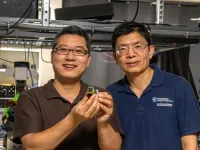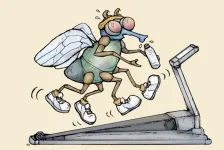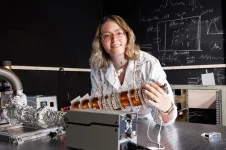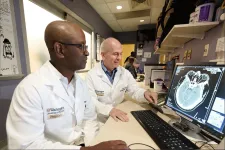(Press-News.org) A new study, published in Nature Communications this week, led by Jake Gavenas PhD, while he was a PhD student at the Brain Institute at Chapman University, and co-authored by two faculty members of the Brain Institute, Uri Maoz and Aaron Schurger, examines how the brain initiates spontaneous actions. In addition to demonstrating how spontaneous action emerges without environmental input, this study has implications for the origins of slow ramping of neural activity before movement onset—a commonly-observed but poorly understood phenomenon.
In their study, Gavenas and colleagues propose an answer to that question. They simulated spontaneous activity in simple neural networks and compared this simulated activity to intracortical recordings of humans when they moved spontaneously. The study results suggest something striking: many rapidly fluctuating neurons can interact in a network to give rise to very slow fluctuations at the level of the population
Imagine, for example, standing atop a high-dive platform and trying to summon the willpower to jump. Nothing in the outside world tells you when to jump; that decision comes from within. At some point you experience deciding to jump and then you jump. In the background, your brain (or, more specifically, your motor cortex) sends electrical signals that cause carefully coordinated muscle contractions across your body, resulting in you running and jumping. But where in the brain do these signals originate, and how do they relate to the conscious experience of willing your body to move?
Starting from the 1960s, neuroscientists have found that electrical activity in the brain ramps up 1-2 seconds before spontaneous voluntary actions. Many scientists thought that the onset of this ramping reflected preparation to move following a preconscious decision to act. But, despite investigations into the origins of this slowly ramping activity, it seemed as though it suddenly emerged “out of nowhere”. In the years since, neuroscientists and philosophers have debated what this ramping means for free will and conscious self-control: if, following an early decision to move, the brain is preparing to move 2 seconds (or more, according to some studies) before you consciously decide to move, might your actions be largely unconsciously predetermined? Understanding the neural origin of this ramping activity is therefore a paramount problem in neuroscience.
The view that there is preconscious information in the brain seconds before action onset has been challenged by neuroscientists like Maoz and Schurger. In particular, in 2012 Schurger suggested that the slow ramping brain activity is part of a larger process, in which slow background fluctuations in motor-cortex activity must reach a certain threshold to initiate movement. If those slow fluctuations help to determine the moment of threshold crossing, then looking back from movement onset ensures that you will observe slow ramping beforehand, even if the ramping is not the outcome of an early preconscious decision to move. In this view, the important event is not the onset of the slow-ramping process but instead the crossing of the threshold. Although compelling, this explanation leaves a key unanswered question: where do these slow background fluctuations in neural activity, commonly known as 1/f noise, come from in the first place, given that the activity of individual neurons fluctuates quite rapidly?
Gavenas’s study is the first to explain how those slow background fluctuations emerge from networks of neurons, where none of the individual neurons by themselves operate on that long of a time-scale. Those slow fluctuations may then, in turn, contribute to a threshold-crossing event, of the kind that is thought to trigger movement, and thus to the slow ramping that is evident before spontaneous action onset and beyond. Gavenas said, “we see similar slow-ramping signals before other kinds of spontaneous behaviors, like coming up with creative ideas or freely remembering things that have happened to you. A similar process might therefore underlie those phenomena, but only time and further research will tell.”
In sum, this is a landmark study because it offers a potential explanation for the origin of slow, spontaneous fluctuations in population-level neural activity, which is a ubiquitous phenomenon in neural systems. In addition, according to Maoz, “It reveals the bias we have as researchers to think that our results uncover a causal mechanism, when it may really be just a correlation.”
###
About Chapman University
Founded in 1861, Chapman University is a nationally ranked private university in Orange, California, about 30 miles south of Los Angeles. Chapman serves nearly 10,000 undergraduate and graduate students, with a 12:1 student-to-faculty ratio. Students can choose from 123 areas of study within 11 colleges for a personalized education. Chapman is categorized by the Carnegie Classification as an R2 "high research activity" institution. Students at Chapman learn directly from distinguished world-class faculty including Nobel Prize winners, MacArthur fellows, published authors and Academy Award winners. The campus has produced a Rhodes Scholar, been named a top producer of Fulbright Scholars and hosts a chapter of Phi Beta Kappa, the nation's oldest and most prestigious honor society. Chapman also includes the Harry and Diane Rinker Health Science Campus in Irvine. The university features the No. 4 film school and No. 66 business school in the U.S. Learn more about Chapman University: www.chapman.edu.
Media Contacts
Molly Thrasher. Director of Public Relations | thrasher@chapman.edu | Mobile: 657-561-4359
Carly Murphy, Public Relations Coordinator | carmurphy@chapman.edu| Desk: 714-289-3196 | Mobile: 714-497-9683
END
(Millbrook, NY) The Hudson River Foundation for Science and Environmental Research (HRF) has awarded $1.7 million to Cary Institute of Ecosystem Studies to monitor the Hudson River’s lower food web for three years. The project is an integral component of the $6.5 million Hudson River Ecosystem Monitoring Program, a collaboration of HRF and New York State Department of Environmental Conservation (DEC) to develop and implement the next generation comprehensive ecosystem monitoring program on the Hudson.
Cary’s Chris Solomon will lead the Interim Lower Food Web Survey to provide ...
BLOOMINGTON, Ind. — Indiana University researchers will lead a multi-institutional team of experts in areas such as informatics, psychology, communications and folklore to assess the role that artificial intelligence may play in strengthening the influence of online communications — including misinformation and radicalizing messages — under a $7.5 million grant from the U.S. Department of Defense.
The project is one of 30 recently funded by the department’s Multidisciplinary University ...
UNIVERSITY PARK, Pa. — Butterflies can see more of the world than humans, including more colors and the field oscillation direction, or polarization, of light. This special ability enables them to navigate with precision, forage for food and communicate with one another. Other species, like the mantis shrimp, can sense an even wider spectrum of light, as well as the circular polarization, or spinning states, of light waves. They use this capability to signal a “love code,” which helps them find and be discovered by mates.
Inspired ...
Fruit flies walking on miniature treadmills are helping scientists learn how the nervous system enables animals to move in an unpredictable and complex world.
Insights from using these fruit fly-sized treadmills were reported Aug. 30 in Current Biology, a Cell Press journal. Several videos of the flies running on the treadmills are available for viewing on the online research paper. The lead author is Brandon G. Pratt, a recent physiology and biophysics Ph.D. graduate of the University of Washington School of Medicine in Seattle and a National Science Foundation ...
A physics student at The University of Texas at Arlington studying ways to measure the mass of tiny particles called neutrinos has earned a prestigious national award for her research.
Senior Kara Stogsdill received the Outstanding Undergraduate Research Award from the Society of Physics Students, an organization of the American Institute of Physics. The award is given to students based on exceptional research achievements in any physics-related field.
Stogsdill’s research is part of the Project 8 Neutrino Mass Experiment, which includes faculty and students from UTA and 13 other universities and national laboratories ...
Pennington Biomedical Research Center is formally launching Greaux Healthy, a public service initiative designed to help improve kids’ health at every age. Developed with funding from the State of Louisiana, Greaux Healthy implements 35 years of Pennington Biomedical research and discoveries to inform tools, resources and programing for children, parents, physicians and educators throughout the state.
The Greaux Healthy initiative is developing a wide variety of educational materials distinctly tailored to four priority populations, including expectant families and parents of infants, ...
Highlights:
Researchers from Michigan State University and South Shore Hospital in Massachusetts have uncovered a connection between two common diabetes drugs — insulin and metformin — identified in wound exudates of diabetic foot ulcers, which may improve their healing.
While analyzing wound exudate (the fluid the body moves and secretes to the site of an injury), researchers discovered the presence of metformin in patients who take the drug orally.
The researchers then explored metformin’s relationship ...
Stroke patients who survive a blood clot in the brain’s blood vessels are prone to developing new blockages during their recovery periods, even if they receive vessel-clearing interventions. In an effort to avoid further clots, doctors at 57 sites around the U.S. tested a possible solution: the addition of anti-coagulant drugs to medicine that dissolves blood clots.
But results from the clinical trial, led by Opeolu Adeoye, MD, head of the Department of Emergency Medicine at Washington University School of Medicine in St. Louis, indicate two such drugs did not improve outcomes.
The findings are available Sept. 4 in The New England Journal ...
A new Energy Frontier Research Center (EFRC), supported by the Department of Energy’s Office of Science and led by SLAC National Accelerator Laboratory, was awarded $14.4 million over four years to advance manufacturing of microelectronics by investigating approaches to building their components in fundamentally new ways.
Instead of moving electrons through conducting metallic interconnects in the miniscule and ever shrinking parts of devices such as microchips used in computers and cell phones, the researchers propose to move information via spin waves that can propagate through semiconductors ...
The built environment — which includes the construction and operation of buildings, highways, bridges and other infrastructure — is responsible for close to 40 percent of the global greenhouse gas emissions contributing to climate change.
While many building codes and benchmarks have focused on constructing “greener,” more energy-efficient new buildings, it is not enough to seek to reduce emissions in operations, said Ming Hu, the associate dean for research, scholarship and creative work in Notre Dame’s School of Architecture. Rather, policymakers and industry leaders ...








